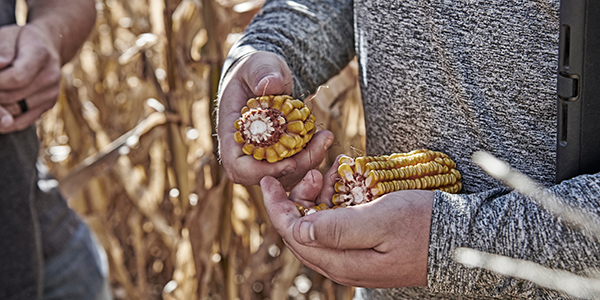AGRONOMICSUPPORT
YOU CAN TAKETO THE FIELD
Seven Tips to Optimize Corn Yield
These are basic tips to refresh our memories, as well as a couple that will help produce higher corn yields. These tips are not in any specific order, but remember that nitrogen is the number one factor we can influence to have a significant bushel increase in corn.
- Hybrid Selection – Correct hybrid placement, traits and seed treatment can all gain significant bushels. Take into consideration the field’s soil type, yield potential, insect pressure and soil-borne diseases.
- Herbicide and Residuals – Taking care of existing weeds with a herbicide and using a residual to hold them off leads to less competition for moisture and nutrients for the corn crop.
- Population – Population varies from region to region and is influenced by several factors such as soil type, rainfall averages and row spacing, to name only a few. Hybrids we plant today are more vigorous with better plant integrity, especially when traits are in the mix. Pushing a couple more thousand plants per acre should not be an issue in most instances and should gain yield at harvest.
- Seeding Depth, Spacing and Soil Moisture – Once a good seed bed is established, we need to take a little extra time to think because there is only one opportunity to get this right. Adequate seed depth is needed to establish a good root base. We need seed that is spaced evenly into moisture with good seed-to-soil contact. The best case scenario for each corn plant is to be evenly spaced with even depth so each plant emerges at the same time with even competition for moisture and nutrients.
- Scouting, Fungicides and Insecticides – Scouting fields throughout the season for insect pressure and diseases can lead to better yields and standability at harvest. A rule of thumb is: if a disease is below the ear shoot leaf at pollination, we do not need to use a fungicide. However, if a hybrid has average health, average stalks, or a hybrid that needs help with late season standability, a fungicide may be warranted.
- Harvest Moisture – Purdue University did a four-year study and 28.4% was the optimum dry weight moisture. My observations and opinion are to combine corn between 22-25 percent. Moisture saves us bushels due to dry weight loss and helps prevent late season yield loss due to stalk lodging, root lodging, dropped ears, kernel damage, etc.
- Nitrogen Rate, Timing and Environment – Nitrogen is the number one factor we can use to influence yield, but environment and timing are also important variables in the equation. Timing is critical. We need early available nitrogen to help the plant set good root depth and mass. V-12 is the biggest uptake of nitrogen in the plant’s lifecycle. We need to have 40% of nitrogen available at that time for optimum yield potential. Side dressing, fertigation, or other means of applying nitrogen between the V4-V5 growth stage can really help that plant in a couple of ways. One reason is, if we get heavy early or late season spring rains, we could lose some nitrogen and experience de-nitrification. The other is, if we get into a good growing season with plenty of moisture and not a lot of stress, this will help the plant put on a couple more kernel rows and kernels long which will lead to more yield.
When spring comes everyone is excited to get started planting and put as many acres in a day as possible. Equipment has gotten bigger, we are more efficient with the technology we have today and can really plant a lot of acres in a day, or even a week, if the weather cooperates. Some farmers that experience a few good weeks of planting can be close to done. That’s why I want to emphasize the fact that we need to make considerations now for hybrid placement by farm considering soil type and population. Think about nitrogen amount and timing. If 180 bushels per acre is a field average, make sure the amount of nitrogen is there for 180 bushel per acre yield goal. Check the seed depth, placement and seed-to-soil contact in every field, not just the first one. Most of the time we have one chance to get the crop in right. These suggestions will hopefully help each of us produce a good-standing, high-yielding crop at harvest time.
Sources and additional information:
- Nitrogen use tied to Success of Corn Crop – Paul Hollis / Southwest Farm Press. https://www.farmprogress.com/nitrogen-use-tied-success-corn-crop
- Kernel Dry Weight Lost during Post-Maturity Drydown Intervals in corn – R.L. Nielsen/ Purdue University. http://www.agry.purdue.edu/ext/corn/research/rpt94-01.htm






Technical Team Agronomist